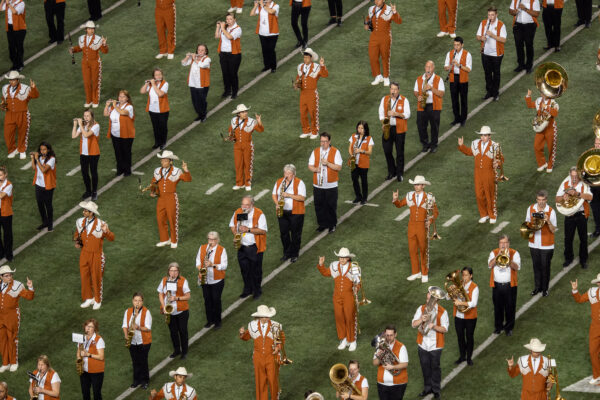If you don’t get goosebumps at the sound of a collegiate band firing on all cylinders — the brass wall of sound from trumpets down to tubas, the 16th-note runs of the woodwinds, and percussion, from the military snare to the funky Caribbean drumline — then there’s something profoundly wrong with you. Likewise, if the hair on the back of your neck doesn’t stand at attention at the sight of a marching band, the immaculate uniforms, the effortless-looking flow of hundreds of players into clever formations, the result of design and discipline rarely seen elsewhere — there may be no helping you.
It might be true for all bands but is especially true for the Longhorn Band and, by extension, the Longhorn Alumni Band, which soon celebrates 60 years of existence. From “March Grandioso” and “Texas Fight” to “The Wabash Cannonball” and “The Eyes of Texas,” the Showband of the Southwest and its degreed counterpart, the Blast from the Past, provide the soundtrack to the Texas experience.
Starting next week and over the subsequent year, UT is attempting to raise $75 million to ensure that the Longhorn Band is the best-supported band in the country. Leading the charge are the ones who know it best, the Longhorn Alumni Band.
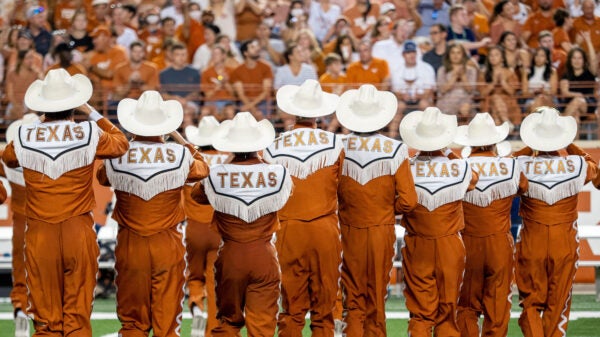
Instant Family
However important the band is to the UT community at large, it is a thousand-fold more important for the students in it, a fact that can only be fully appreciated by members of the Longhorn Alumni Band.
“There’s no more closely knit group of Orangebloods than the Longhorn Band,” says Kent Kostka, B.A. 1991, who was leader of the 70-member trumpet section and president of the 350-member Longhorn Band in 1988-89. The band gives students a support structure from the day they get on campus. “There’s a place you can go. Any time of the day, there’s a lounge there for the band students so you can find people you know and study with them. It’s a truly deep and supportive family on campus and that’s what makes these people so close.”
Much of that closeness is simply a function of time spent together in the “hurry-up-and-wait” world of band. “You spend literally hundreds and hundreds of hours on buses with each other, waiting in line, rehearsing, performing, standing around waiting to go do a 10-minute gig for the president, and by the time you leave campus, these people are your best friends.”
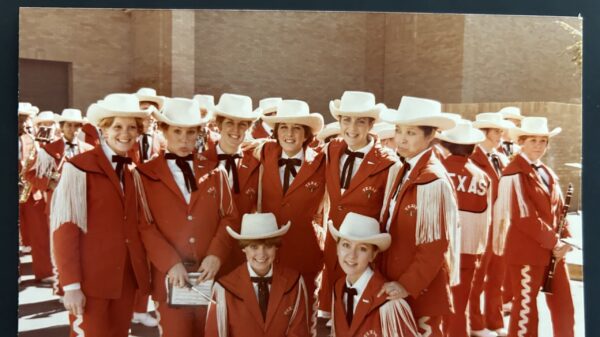
Cathy Sorsby, B.S. 1982, MBA 1994, once leader of the 32-piece piccolo section and president of the Longhorn Band’s service sorority Tau Beta Sigma, heartily agrees. “From before classes started for me as a freshman, I had an instant family that I had spent several weeks with already.” Sorsby adds that shared hardships make the bond even stronger. “When I was there, they called it Hell Week — the week you tried out for the band. It’s very hot. You’re outside all day. Some people had tennis shoes that melted on the AstroTurf. It’s an instant family of camaraderie and fun. I had all that behind me by the time I started classes.”
Sorsby remembers her favorite part of the week was going to rehearsals on Monday, Tuesday and Thursday nights, 7 to 9, at the stadium. “There was a track around the field then, so you got to see a lot of students that way. There were bats flying in the air — it was just so much fun!” says Sorsby, now in her eighth year of service on the Alumni Band’s Board of Trustees.
Even waking up on game days was fun. “We had to be there early, and it took up all day. You just felt so much a part of the University. Being in the Longhorn Band, you always represented the University, and it is a great band with high musical standards. It was just a great rush to be there on the field, perform and look up at the (then) 80,000 people in the stands. It’s just a high like nothing else.”
Kostka remembers a common speech his directors would give. “They’d say, ‘Look to your left and your right. You are very likely to see your spouse in here,’ and they are not kidding! ‘You are going to see the people who are going to be your friends for the rest of your life. They will be in your wedding. Your children will grow up with their children. You will see them at reunions for the rest of your life.’ It’s that way for all of us.”
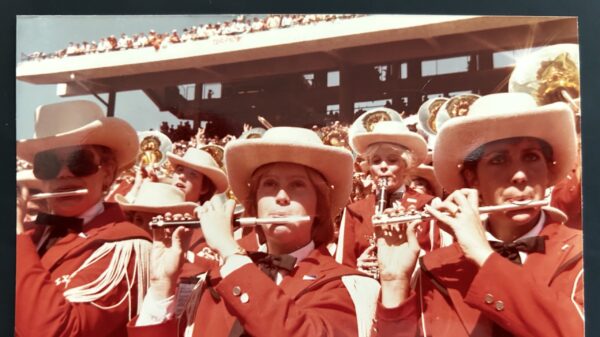
Teaching Teamwork
There always have been a lot of engineering majors in the band, observes Sorsby, herself a mechanical engineering graduate. Rex Tillerson, who had a long career as an oil and gas executive before becoming Secretary of State, credits it all to the Longhorn Band.
Instead of recruiting directly from the College of Engineering, several of the big oil companies would go straight to band director Vincent DiNino’s office and ask for the names of seniors in the band who are also engineering majors. They didn’t want the smartest student if they couldn’t work with others. They wanted people who knew how to work with others as a team, and assumed they would all be smart anyway.
The Refrain: Longhorn Alumni Band
Such a powerful student experience leads naturally to a desire as an alumnus to experience the magic again. As a student, Sorsby would see the Alumni Band come back each year. “I knew for five years that I would be part of the Alumni Band. I started coming back right away as did all my friends from band. It was just so much fun to have a college reunion where you go back and do exactly the same thing that you did when you were at UT. You’re not standing around at a cocktail party; you’re putting on a marching show!”
There was no gap for Kostka either between his student and Alumni Band days. “Because I was president of the band, they hit you up right away after graduation.” And it’s been continuous involvement ever since.
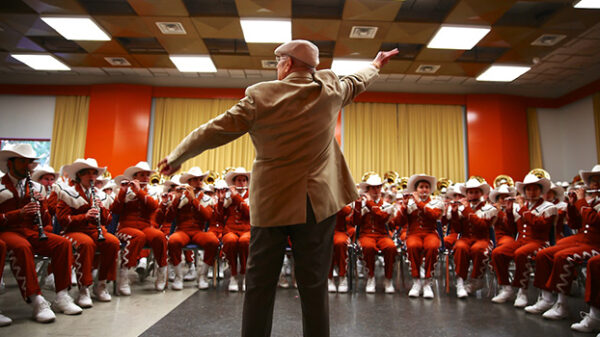
The story of the Alumni Band begins, as many UT traditions do, with the aforementioned DiNino, the first director with faculty status. In 1964, DiNino and his wife, Jane, approached James and Patsy Hejl to start an alumni band. Using the Cactus Yearbook and the Austin phone book, the Hejls started a stack of index cards on their kitchen table containing names and phone numbers. They recruited three other former Longhorn Band couples to help and quickly amassed 500 former band members who became the first to call themselves the Blast from the Past. That year 67 alumni reunited.
DiNino, who lived to 95, saw the Alumni Band blossom into the joyful behemoth we see each year — alumni of every size, shape and vintage taking the field in their orange vests, white shirts and black pants. The Blast from the Past now exceeds 4,000 members in 12 countries.
The Ingathering
Each year more than 500 gather for Alumni Band Weekend, and this year Alumni Band Day is Sept. 30, Texas vs. Kansas. Both bands perform half-time shows, and then join forces for a combined ensemble that sometimes exceeds 1,000 members on the field. The Alumni Band has a storage facility in Austin where it keeps 800 vests (after the annual laundering) and the larger loaner instruments such as tubas, euphoniums and large percussion instruments throughout the year. Not every alumnus owns their own instrument.
The weekend begins with a Friday night rehearsal and business meeting attended by anyone who can make it, some years in the Band Hall, other years seated in the stadium.
On Saturday, if the game is at night, the call time might be a leisurely 9 a.m. The Alumni Band practices marching alone and then with Longhorn Band. For many years they have held the marching practice in the football practice facility known as the Bubble, and since it has an airlock between two sets of doors, in which 20-30 people must wait at any given time, it can take 30 minutes for the 800 people to get in and another 30 to get out. More togetherness. After a break for lunch, they don their vests and march to the stadium.
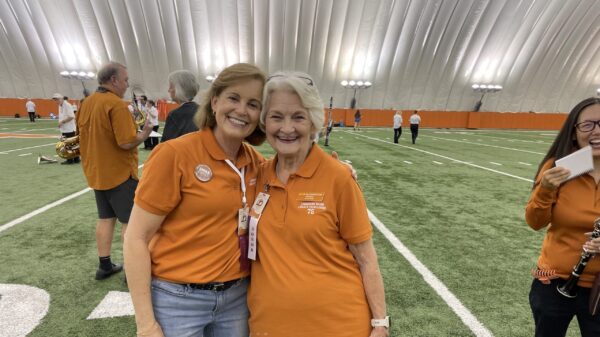
But the kickoff could just as easily be at 11 a.m., in which case alumni rehearsal starts at 5:30 a.m. They get no sympathy from students, who arrive at 5 a.m. to run through their show first.
Though much of the music has remained the same for decades, there occasionally is new music to learn, as well as marching styles. Sorsby explains that in her day, one would reverse direction with a “counter-march,” or two 90-degree turns. Last year, they changed to a to-the-rear turn, or turning 180 degrees at once. “For some alumni, that was just never a move that we did on the field!”
Beyond Band Weekend
But Alumni Band is not just about one weekend a year. Band chapters in Dallas, Houston, Austin and San Antonio march in parades and play for Texas Exes chapter events (for a nice donation to the Longhorn Band scholarship fund). What’s more, alumni fill in for students over the holidays at basketball games. “The current students are a lot better than we are!” says Kostka. “We have some true white-haired guys that show up at some of these things, and no one cares — it’s all part of the family.”
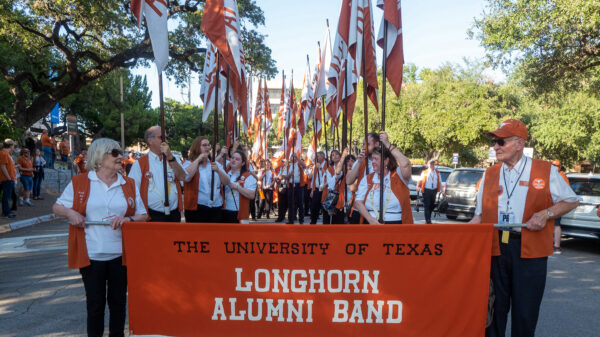
Though it is a great way to keep in touch with classmates, it’s far more than that. “I have friends that are 10, 15, 20 years from my time in the band,” Kostka says, “and yet I’ve seen them so many times over the years I get together and have a beer at the Posse with people I was not in school with.”
A Call to Action
“The Longhorn Band has given us all lifelong friendships,” Sorsby says. “It gave us leadership skills, job skills and countless benefits. Now is the time we need to give back to the band because it has a great need.”
The Showband of the Southwest is not on the verge of vanishing. But there are ways in which other bands are better supported, especially in the Southeast Conference. At some SEC schools, all of the instruments are university-owned, and so look the same on the field and sound better. Texas students mostly play their own. “It would make a significant difference to have identical instruments,” Kostka says. Some of the better-funded bands in the SEC and Big 10 buy brand new uniforms every five years. Some schools in the SEC have just built dedicated practice facilities for their bands. Texas A&M recently opened a new $40 million building with a state-of-the-art band hall. Other major college bands offer scholarships to every band student. “We all want the Longhorn Band to lead the way,” Kostka says.
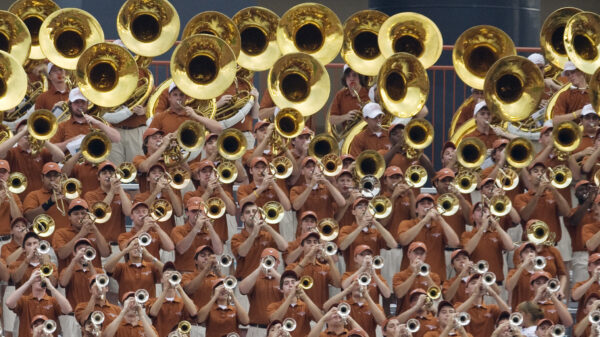
UT gives about 120 partial scholarships for the neediest of the 350 members. In the 1980s, 10 students got scholarships. Now almost 200 students receive a scholarship between $1,500 and $3,500. The new goal is that every student in the Longhorn Band gets a scholarship.
Operating costs for the band include expenses related to the directors and graduate-student assistants, instrument upkeep, uniforms, meals for students on game days. It adds up quickly, to about $1 million a year. Need is everywhere. “The band hall they’re in now is the same band hall I was in,” Sorsby says, “and it wasn’t brand new when I was there!”
There are two basic ways to give. The first and simplest is by outright donations. Sorsby made her first gift when she was in her 20s, and it was substantial. At the time she was living in Houston, and the Houston chapter of the Texas Exes was doing a big push to endow scholarships by matching members’ donations. She endowed a scholarship for a female student in the Longhorn Band. “It’s a great feeling to know that money is with UTIMCO (University of Texas/Texas A&M Investment Management Company) and is invested wisely. I know that it will supply funds for a student. How great is that?” Her money has grown for nearly 35 years.
It's a great feeling to know that money ... is invested wisely."
The second way to contribute is through a planned gift, or estate gift. While Kostka has been active in the Alumni Band for decades, he recently became even more involved when he joined UT as a development officer for gift planning. When the Longhorn Band came to Texas Development for a fundraising effort, Kostka was a natural choice to help lead the campaign.
With Kostka’s help, the University recently launched the Back the Band campaign to raise awareness about the Longhorn Band’s needs and to ensure the Showband of the Southwest marches into the SEC in 2024 as the best-supported band.
Beyond his devotion to the band, Kostka has personal motivation to get people to act on their good intentions. His mother, Marilyn Kostka, B.M. 1964, was a music education professor at UT and had always hoped to set up a scholarship for a someone studying to be an elementary music teacher. Despite Kent and his wife both being attorneys, she never put those plans in writing or let UT know her intentions. Later, Kent and his sister set up a scholarship endowment in her name, but she never had the chance to see it or be recognized by UT for her gift. “A lot of people have these plans and say, ‘Oh, I’ll do that someday,’ but by the time they’re older or have an illness, that’s not the time to be doing planning.”
He adds, “People do planned giving for their families, and this is your family.”
The family nature of the band was driven home recently, when UT’s first Black drum major, John Fleming, B.M. 1992, died, just 55. At his funeral in the church where he was very active, Kostka recalls more than half of the attendees were Alumni Band members. After the service, the group decided to go for Mexican food, and 70 people took over a restaurant, happily remembering John and catching up with dear friends.
Kostka recalls, “I got home and my wife asked if I was okay, and I said, ‘I hate to say it, but this is one of the best days I’ve had in a long time.’ She said, ‘What are you talking about? You were just at the funeral of a dear friend!’ I said, ‘I know. Give credit to John — he brought all of us together.”
Strengthening support for the Longhorn Band ensures the future of the soundtrack of the UT experience, the future of teamwork and leadership that band teaches, and the structure that gives rise to this extraordinary extended family.
Back the Band
In 2024, the Longhorn Band will celebrate its 125th season of ringing the cowbells, shaking the fringe and raising the spirits of Longhorn Nation. The band, alongside Texas Athletics, will also make the move to collegiate sports’ biggest stage — the Southeastern Conference. With your help, the Showband of the Southwest can march into the SEC as the country’s best and best-supported marching band. Learn more.
Explore Latest Articles
Jul 11, 2025

